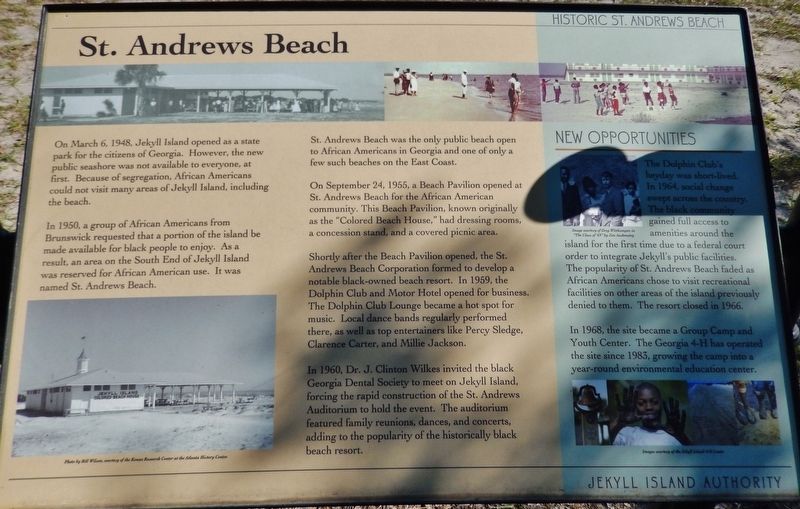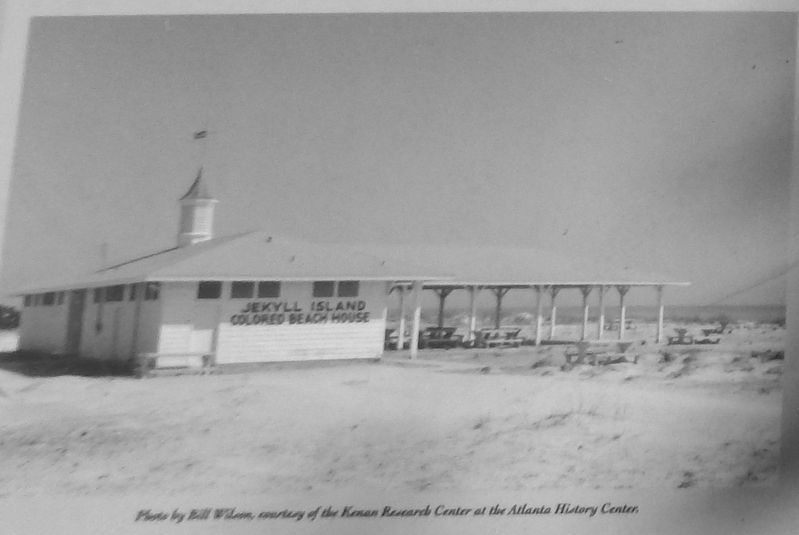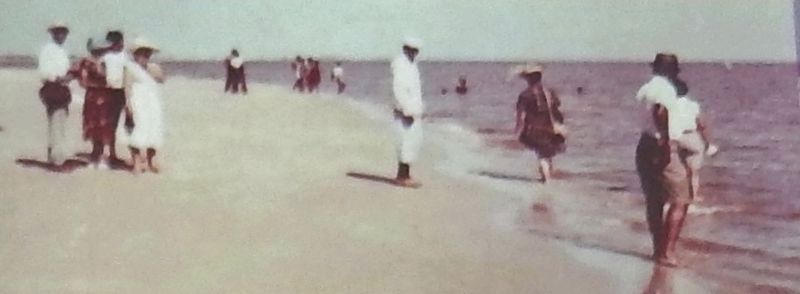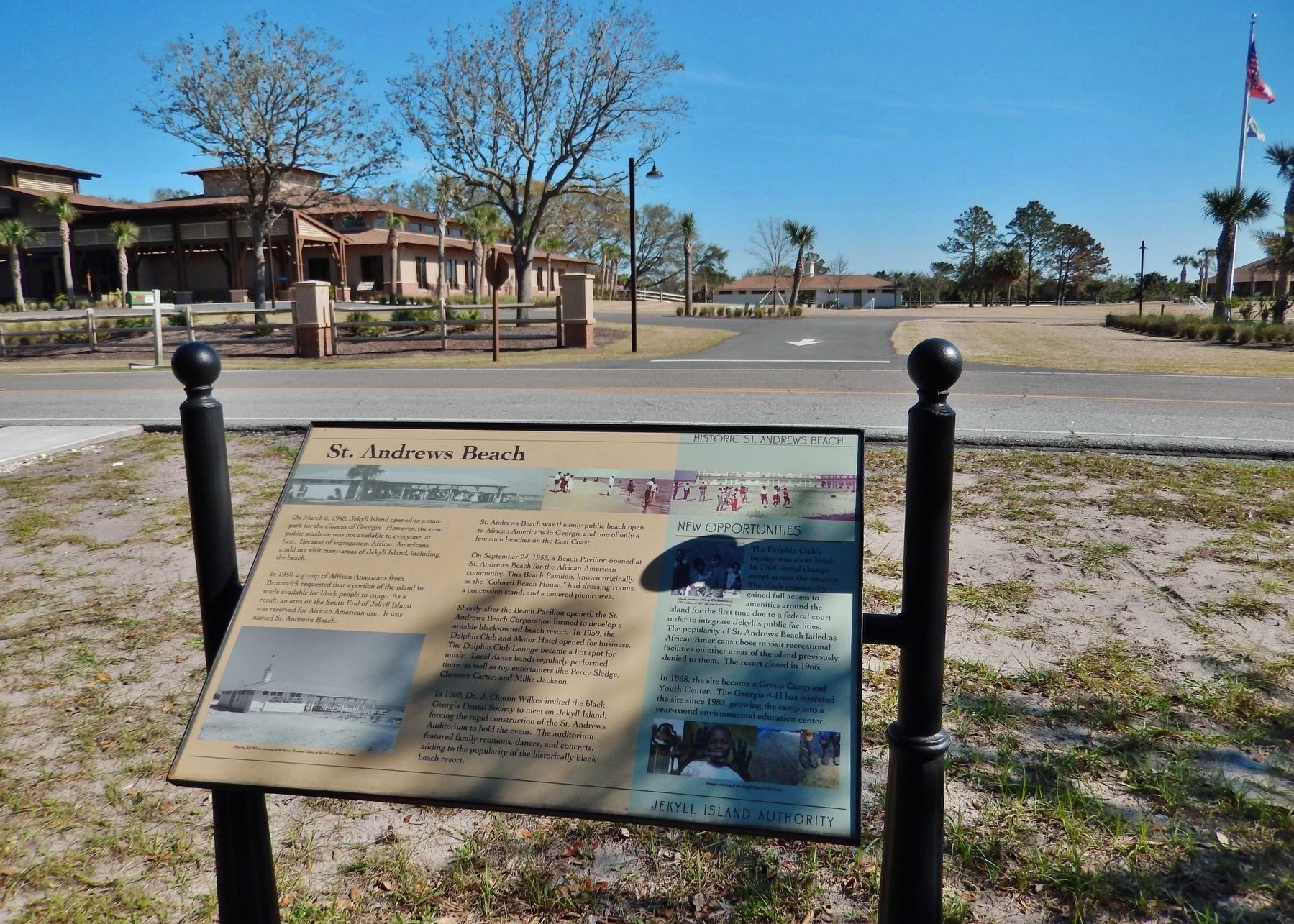Jekyll Island in Glynn County, Georgia — The American South (South Atlantic)
St. Andrews Beach
Historic St. Andrews Beach
On March 6, 1948, Jekyll Island opened as a state park for the citizens of Georgia. However, the new public seashore was not available to everyone, at first. Because of segregation, African Americans could not visit many areas of Jekyll Island, including the beach.
In 1950, a group of African Americans from Brunswick requested that a portion of the island be made available for black people to enjoy. As a result, an area on the South End of Jekyll Island was reserved for African American use. It was named St. Andrews Beach.
St. Andrews Beach was the only public beach open to African Americans in Georgia and one of only a few such beaches on the East Coast.
On September 24, 1955, a Beach Pavilion opened at St. Andrews Beach for the African American community. This Beach Pavilion, known originally as the "Colored Beach House," had dressing rooms, a concession stand and a covered picnic area.
Shortly after the Beach Pavilion opened, the St. Andrews Beach Corporation formed to develop a notable black-owned beach resort. In 1959, the Dolphin Club and Motor Hotel opened for business. The Dolphin Club Lounge became a hot spot for music. Local dance bands regularly performed there, as well as top entertainers like Percy Sledge, Clarence Carter, and Millie Jackson.
In 1960, Dr. J. Clinton Wilkes invited the black Georgia Dental Society to meet on Jekyll Island, forcing the rapid construction of the St. Andrews Auditorium to hold the event. The auditorium featured family reunions, dances, and concerts, adding to the popularity of the historically black beach resort.
(sidebar)
New Opportunities
The Dolphin Club’s heyday was short-lived. In 1964, social change swept across the country. The black community gained full access to amenities around the island for the first time due to a federal court order to integrate Jekyll's public facilities. The popularity of St. Andrews Beach faded as African Americans chose to visit recreational facilities on other areas of the island previously denied to them. The resort closed in 1966.
In 1968, the site became a Group Camp and Youth Center. The Georgia 4-H has operated the site since 1983, growing the camp into a year-round environmental education center.
Erected 2016 by Jekyll Island Authority.
Topics. This historical marker is listed in these topic lists: African Americans • Civil Rights • Parks & Recreational Areas. A significant historical date for this entry is March 6, 1948.
Location. 31° 1.085′ N, 81° 25.618′ W. Marker is on Jekyll Island, Georgia, in Glynn County. Marker is on South Beachview Drive, 2.3 miles south of Jekyll Island Causeway (Georgia Route 520), on the right when traveling south. Marker is located directly across the highway from Camp Jekyll. Touch for map. Marker is at or near this postal address: 550 South Beachview Drive, Jekyll Island GA 31527, United States of America. Touch for directions.
Other nearby markers. At least 8 other markers are within walking distance of this marker. Separate But Equal? (within shouting distance of this marker); The Dolphin Club Lounge (about 300 feet away, measured in a direct line); The Beach Pavilion (about 500 feet away); The Dolphin Motor Hotel (about 500 feet away); Beach Access (about 700 feet away); The Wanderer — Arrival (approx. half a mile away); The Wanderer — Built For Speed (approx. half a mile away); The Wanderer — Timeline: Continued (approx. half a mile away). Touch for a list and map of all markers in Jekyll Island.
Related markers. Click here for a list of markers that are related to this marker. Historic St. Andrews Beach
Also see . . . St. Andrews.
In 2008, the Jekyll Island History Museum, the Jekyll Island Authority, and the Friends of Historic Jekyll Island commemorated the survivors of the slave ship The Wanderer, the next to last ship documented to transport slaves to US territory in the prohibited Atlantic slave trade. The Wanderer was built in Setauket, New York as a pleasure boat, but it was acquired by Southerners who opposed the prohibition on the Atlantic slave trade. They had it converted in Angola to carry slaves, and the captain purchased more than 500 to take to the US. After a six-week voyage in which more than 100 slaves died, on November 28, 1858, The Wanderer anchored near the southern portion of Jekyll Island. Its crew took 409 to 465 enslaved Africans ashore, smuggling them to the mainland. (Submitted on March 17, 2018, by Cosmos Mariner of Cape Canaveral, Florida.)
Credits. This page was last revised on March 24, 2018. It was originally submitted on March 17, 2018, by Cosmos Mariner of Cape Canaveral, Florida. This page has been viewed 909 times since then and 72 times this year. Photos: 1, 2, 3, 4, 5. submitted on March 17, 2018, by Cosmos Mariner of Cape Canaveral, Florida. • Andrew Ruppenstein was the editor who published this page.




